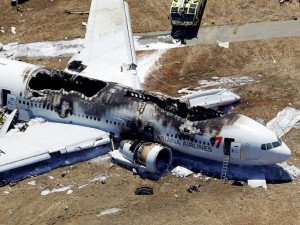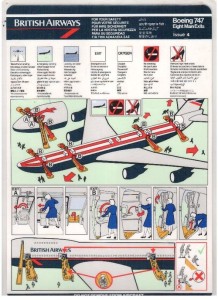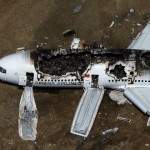 The Asiana Airlines plane crash yesterday at San Francisco International Airport hit home with me since I have flown on that airline and that flight going to and from Korea. This South Korean airline has been one of my favorites for flying back and forth to visit family and train with my Hapkido instructors in South Korea. I feel for the two sixteen year old Chinese students who died, and am thankful that out of the 291 passengers, there were only two deaths. 182 people were taken to hospitals. So this brings me to today’s self-defense and safety lesson. I hope it will help you when you fly if you ever have to face something and scary as those on the Asiana flight had to yesterday.
The Asiana Airlines plane crash yesterday at San Francisco International Airport hit home with me since I have flown on that airline and that flight going to and from Korea. This South Korean airline has been one of my favorites for flying back and forth to visit family and train with my Hapkido instructors in South Korea. I feel for the two sixteen year old Chinese students who died, and am thankful that out of the 291 passengers, there were only two deaths. 182 people were taken to hospitals. So this brings me to today’s self-defense and safety lesson. I hope it will help you when you fly if you ever have to face something and scary as those on the Asiana flight had to yesterday.
What do you do when you get on an airplane?
Once you have stowed your carry on, sat down, and buckled up, what do you do? Now be honest, do you read the safety information card and listen to the flight attendant’s safety instructions? Or do you just go about your business, reading, chatting, using your cell phone or ipad until told to turn it off, and completely ignore and tune out the person telling you where the exits are, how to use your seat belt, and where the nearest bathroom is located. Do you read the safety information card? Have you ever read the safety information card?
Think safety when getting on an airplane.
Let me share with you what I do. I always listen to the flight attendant’s instructions. Always! I shut up, look up, and pay attention. And the primary reason I’ve always done this, and will continue to do so, is because I believe it is impolite not to. That’s right, it’s impolite not to. As a teacher and speaker, I know what it feels like to be presenting to a group of people and have some not listen. I’ve always felt it is respectful to listen to flight attendants as they do their job, especially since they are doing it for us. It is the same reason you will never catch me going through a supermarket check out talking on a cell phone and ignoring the person helping me. It’s just common courtesy to pay attention to and acknowledge those people who are waiting on us, or talking to us.
 Always read the safety information card.
Always read the safety information card.
After I’ve sat down, and either before or right after the flight attendant’s safety instructions, I always pull out the safety information card and read through it. Usually I do this before the flight attendant tells us to. I always look around and visually note where each exit on the plane is located in relation to my seat. I also pay attention to who is where on the plane. I like to know what kind of people are around; men, women, elderly, kids, people who need help, or those that look in good shape. I never like being anywhere that I don’t know how to get out of, and who is around me. Just a habit I guess. But it is a safety habit I encourage others to get into.
Okay, so some of you are saying, “Good for you Mr. Polite Awareness Guy. Here’s an extra cookie to go with your coffee for being such a great airline passenger.” And I’m sure some think this is going overboard, not necessary, and would tell me to “get a life.” Well, I always thing being polite is necessary, but the safety habits are just a part of me. Maybe even more so now that I write about and teach people to be more safe. I never really thought much about doing these simple things, they are just what I do, and I do a lot of things others don’t. However, it made me sit up and take notice when I read the book The Unthinkable: Who Survives When Disaster Strikes and Why by Amanda Ripley. In this book, Ripley shares a little about people who read the safety information card.
In her book, Ripley reports on Mr. Paul Heck, a survivor of the 1977 Pan Am accident in the Canary Islands. When the plane was hit by another plane on the airstrip while waiting to take off, 326 of the 396 people on board were killed. (583 people died total when you include the passengers on the KLM aircraft that hit the Pan Am flight.) Many of those who died on the Pan Am aircraft would have lived if they had gotten off the plane before smoke and fire killed them. Paul Heck, sixty-five, reacted immediately and told his wife Floy, seventy, to follow him, which snapped her out of her daze, and led her off the plane. Others sat like zombies in a state of paralysis and perished.
Did you read that? Many of those who died would have lived if they had gotten off the plane and not sat like zombies!
This passage from Ripley’s excellent book provides some very important information:
“At the time of the Tenerife crash, psychologist Daniel Johnson was working on safety research for McDonnell Douglas. He became fascinated by this paralysis behavior, which had been observed in other plane crashes as well. Floy and Paul Heck are both deceased now. But a few months after the accident, Johnson interviewed them both. He made an important discovery. Before the crash, Paul had some something highly unusual. During the long delay before takeoff, Heck had studied the 747’s safety diagram. He even walked around the aircraft with his wife, pointing out the nearest exits. He had been in a theater fire as an eight-year-old-boy, and ever since, he had always checked for the exits in an unfamiliar environment. Maybe this is a coincidence. But it is also possible that when the planes collided, Heck’s brain had the data it needed to take action.” Read Wiki on the Tenerife airport disaster.
 Why not stack the deck in your favor?
Why not stack the deck in your favor?
I’m not suggesting that I will survive an aircraft disaster before anyone else, just because I read the safety information card and pay attention to the flight attendants, but evidence shows that it just might help. Personally, I’m all for stacking the deck as much in my favor as I possibly can when it comes to survival. If Heck’s story doesn’t convince you to pay more attention, here is another example from Ripley’s The Unthinkable.
“The National Transportation Safety Board has found that passengers who read the safety information card are less likely to get hurt in an emergency. In a plane crash at Pago Pago three years before the Tenerife accident, all but 5 of the 101 passengers died. All the survivors reported that they had read the safety information cards and listened to the briefing. They exited over the wing, while other passengers went toward other, more dangerous but traditional exits and died.”
One thing this accident should remind us of is to take note of the important safety briefings at the start of each flight and to know where the nearest exits are! You always want to know where the exits are and you must leave your bags behind and listen to the instructions of the crew members. A speedy evacuation saves lives!
Be Prepared and as Safe as You Can Be!
The bottom line is: I want to be prepared and safe as I can be. I want the same for you! Not paranoid mind you, but I will stack the deck in my favor whenever I can, especially when it is so simple to do so in some cases. Keeping oneself safe is not just going to the gym to practice my martial arts and self-defense skills. It’s not just going to the range to practice shooting skills, or practicing with other weapons I could use to defend myself. Keeping safe is a combination of everything one does, with situational awareness being one of the most important ingredients. (If you haven’t signed up for the Warrior’s Edge newsletter and downloaded the free guide to situational awareness, do so at the right of this page.) I will always listen to the flight attendant’s briefing, no matter how many times, out of courtesy and to be better prepared. I will always read the safety information card, even on small planes I am very familiar with. I will always look around and make note of all the exits and the other passengers on board with me. You don’t have to do the same, but I seriously suggest you do. It might just be the difference between life and death.
Check out The Unthinkable: Who Survives When Disaster Strikes and Why by Amanda Ripley on amazon:

Be the first to comment on "Safety Habits Stack The Deck For Your Survival – Asiana Airlines Crash"